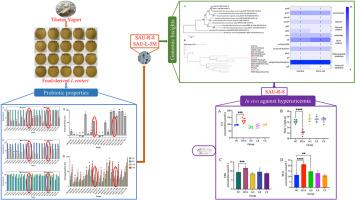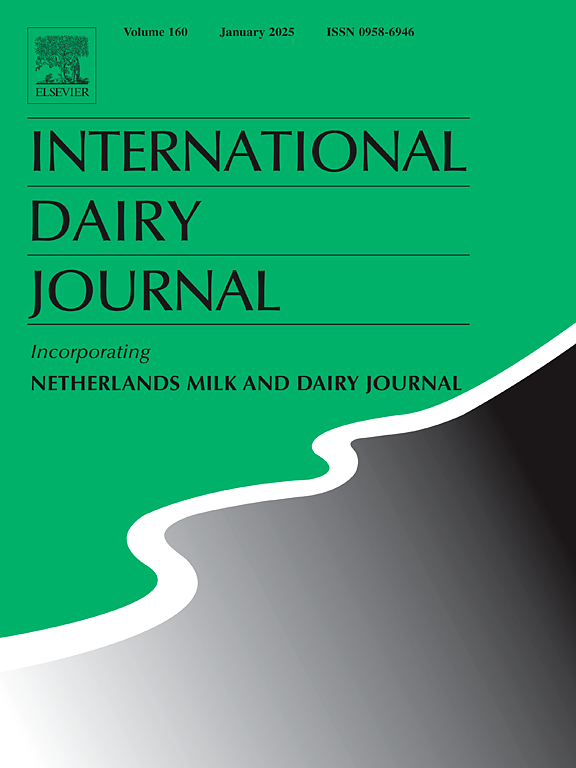Probiotic properties and genomic insights of Limosilactobacillus reuteri isolated from Tibetan fermented yak milk with potential anti-hyperuricemic activity
IF 3.4
3区 农林科学
Q2 FOOD SCIENCE & TECHNOLOGY
引用次数: 0
Abstract
Limosilactobacillus (L.) reuteri from traditional fermented dairy products is underexplored for hyperuricemia management. Nineteen strains were isolated from Tibetan fermented yak milk. SAU-R-8 and SAU-L-3M exhibited outstanding probiotic traits, including high acid tolerance (>93 % survival at pH 2.0), bile salt resistance (∼70 % in 0.3 % (w/v) bile), and strong gastrointestinal survivability. SAU-L-3M showed high hydrophobicity (96.1 %) and SAU-R-8 demonstrated notable auto-aggregation (60.24 %). SAU-L-3M and SAU-R-8 completely degraded inosine and guanosine (1.26 mmol L−1) within 1 h and inhibited xanthine oxidase by 33.89 and 27.73 %. Genomic analysis revealed shared genes for purine metabolism, SCFA production, adhesion, and stress resistance, with SAU-R-8 clustering with food-origin L. reuteri and SAU-L-3M with human-derived lineages. In hyperuricemic mice, SAU-R-8 reduced serum uric acid by 36.4 % and improved kidney function. These findings support their potential as probiotic candidates for functional food applications.

传统发酵乳制品中的罗伊氏乳杆菌在高尿酸血症管理中的应用尚未得到充分开发。su - r -8和su - l - 3m表现出优异的益生菌特性,包括高耐酸性(pH 2.0时存活率>; 93%),胆盐抗性(在0.3% (w/v)胆汁中约70%)和强胃肠道存活率。su - l - 3m具有较高的疏水性(96.1%),su - r -8具有显著的自聚集性(60.24%)。au -L- 3m和au - r -8在1 h内完全降解1.26 mmol L−1的肌苷和鸟苷,对黄嘌呤氧化酶的抑制作用分别为33.89%和27.73%。基因组分析揭示了嘌呤代谢、SCFA产生、粘附和抗逆性的共同基因,其中su - r -8与食物来源的罗伊氏乳杆菌聚类,su - l - 3m与人类来源的谱系聚类。在高尿酸血症小鼠中,au - r -8可使血清尿酸降低36.4%,并改善肾功能。这些发现支持了它们作为功能性食品应用的益生菌候选物的潜力。
本文章由计算机程序翻译,如有差异,请以英文原文为准。
求助全文
约1分钟内获得全文
求助全文
来源期刊

International Dairy Journal
工程技术-食品科技
CiteScore
6.50
自引率
9.70%
发文量
200
审稿时长
49 days
期刊介绍:
The International Dairy Journal publishes significant advancements in dairy science and technology in the form of research articles and critical reviews that are of relevance to the broader international dairy community. Within this scope, research on the science and technology of milk and dairy products and the nutritional and health aspects of dairy foods are included; the journal pays particular attention to applied research and its interface with the dairy industry.
The journal''s coverage includes the following, where directly applicable to dairy science and technology:
• Chemistry and physico-chemical properties of milk constituents
• Microbiology, food safety, enzymology, biotechnology
• Processing and engineering
• Emulsion science, food structure, and texture
• Raw material quality and effect on relevant products
• Flavour and off-flavour development
• Technological functionality and applications of dairy ingredients
• Sensory and consumer sciences
• Nutrition and substantiation of human health implications of milk components or dairy products
International Dairy Journal does not publish papers related to milk production, animal health and other aspects of on-farm milk production unless there is a clear relationship to dairy technology, human health or final product quality.
 求助内容:
求助内容: 应助结果提醒方式:
应助结果提醒方式:


